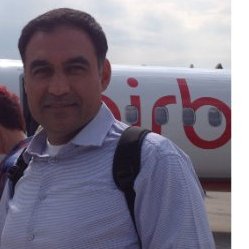M2M IN DEMANDING INDUSTRIES

M2MAPPS: Can you summarize Quake Global’s core competence and its key activities?
SERGIO RAMOS: QUAKE provides communications systems that enable global monitoring, tracking and control of corporate assets. We’re the market leader. Our intelligent network-agnostic devices allow customers to deploy end-to-end, customized solutions using the worldwide network of our strategic partners. That’s our core competence in a nutshell and we’ve been engaged in these activities for over three decades.
M2MAPPS: In what way is your offer network-agnostic?
SERGIO RAMOS: We provide global connectivity over terrestrial or satellite networks or both on a single platform. Right now that’s a unique capability. This allows our customers to create devices that employ the specific network capabilities they require for their applications: no more and no less. But when business opportunities grow the functionality of the platform can also grow. Our network-agnostic technology will automatically select and employ the appropriate data network. This process maximizes our clients’ communication connectivity options. The intelligence in these devices enables connectivity to be based on dynamic environmental and business conditions and this results in a unified communications protocol that provides optimized global solutions. Handover from one network to another — terrestrial to satellite and vice versa is seamless, but of course it’s not needed for all solutions. However, the functionality is there whenever a customer needs it and it means that multi-network coverage can be provided without changing anything on the device.
M2MAPPS: What is the secret sauce that enables handovers between terrestrial and satellite networks?
SERGIO RAMOS: There’s no secret. It comes from the experience we accumulated in working with terrestrial and satellite networks for three decades and the resulting in-depth understanding of the individual protocols. We were able to take that knowledge and abstract it in order to provide customers with a single unified interface. We probably have a better understanding of the specifics of satellite protocols than the operators since we are deploying point hardware and creating applications that run on their networks.
M2MAPPS: Which market sectors need ubiquitous coverage? Terrestrial as well as satellite.
SERGIO RAMOS: There are quite a few but the key sectors are heavy equipment, particularly mining equipment, the oil and gas industry and maritime, where connectivity is needed over open waterways. However it’s not simply a matter of geographical location. There are scenarios where multi-network tracking of assets is mandated by governmental regulations. I’d like to add something about our robust, intelligent platforms. They do more than simply provide connectivity. They enable customized, cost-effective programming of our devices, which is this done using APIs that Quake supports. In addition customers can easily create applications such as remote maintenance that run on the platform, either in an autonomous mode or in a control mode. We will embed these applications in the platform. Quake can also create the apps; taking them from an idea through to deployment in the field.
M2MAPPS: Why did you decide to add an RFID capability?
SERGIO RAMOS: It was a natural addition and extension of our asset tracking capability. RFID tags allow us to track low-cost assets, going from factory floors through to warehouses and out to the field. It represents a seamless combination of local area and wide area communications that can be used to track people as well as regular assets. For example, solutions that monitor patients as they move around in a hospital, and if they need to be transported to another location because specialized treatment is needed coverage, then continues when they are in the ambulance and when they arrive at their destination. In addition, and this is a key feature of the solutions we have developed, medical data on the patient will be collected and communicated to the specialist facility along with the estimated time of arrival. Therefore we can now employ the technology and solutions developed for machine-to-machine communications to be used for people-to-people communications, particularly those that are mission critical.
M2MAPPS: Where do you see the industry going in the next 18 months?
SERGIO RAMOS: In the case of asset tracking we’ll see an increased emphasis on employing this technology for the Internet of Everything as well as workflow processes and the tracking of assets before they really become an asset, by which I mean that tracking product lifecycles. A typical process might start with the movement of materials to the factory floor where various actions are taken that will turn the material into a tangible asset. A workflow solution will track the different actions and the time taken to complete them, which in turn will establish the efficiency of the process. In other words, is the asset being produced in the optimum way? An ERP (enterprise resource planning) system can perform the same task in a similar way, but ERP is a complex, enterprise-wide system.
Company: Quake Global
Quake Global is the world’s leading provider of industrial asset monitoring and tracking communications systems. These systems enable end users to improve daily operations and reduce costs through efficient and cost-effective real-time management of assets anywhere on the planet. Quake Global is the only provider of network-agnostic M2M communications systems that offer a unified communications protocol for data coverage across multiple global satellite and terrestrial networks from a single device. In addition the company offers the industry’s largest selection of customizable, fully programmable M2M solutions for rugged industrial applications. For more information, visitwww.quakeglobal.com.
